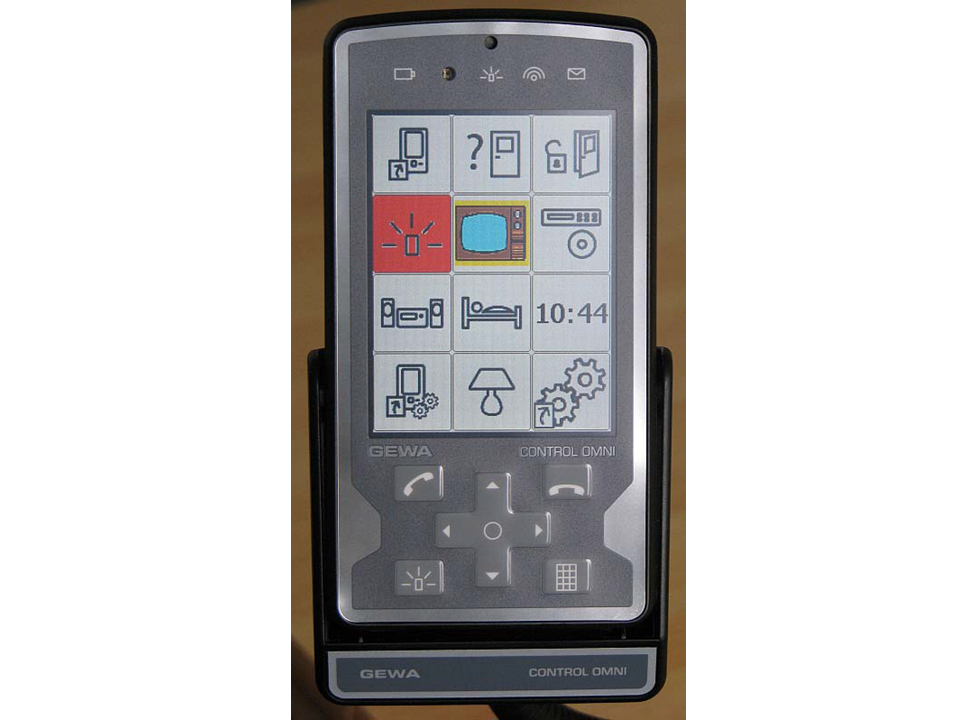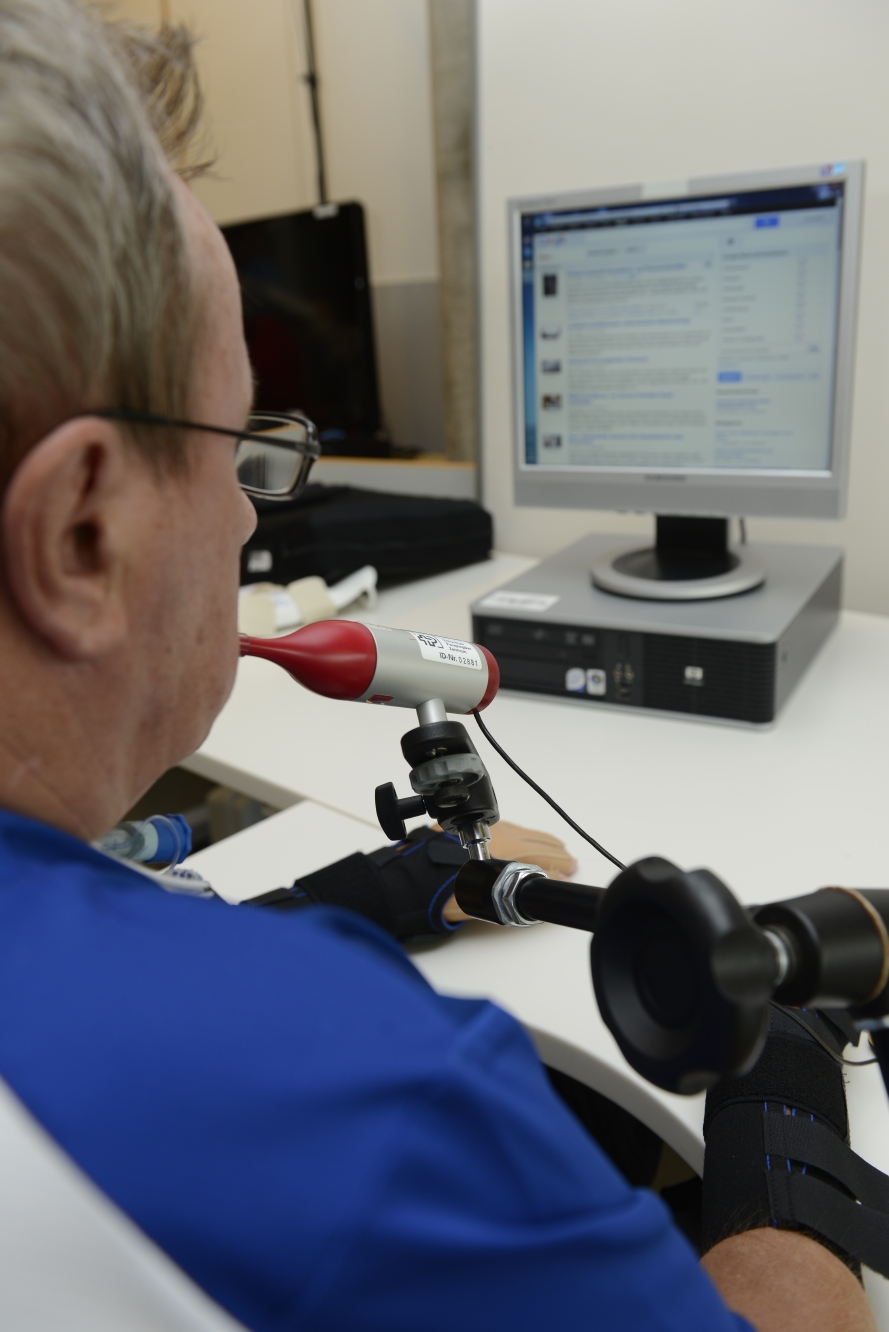
- 6 minutes to read
- 07 January 2022
At a spinal cord injury (SCI) level where hand and arm muscles are only partially innervated or not at all (tetraplegics), many daily activities such as pressing a common TV remote control, grasping the telephone receiver or pressing the light switch can become impossible.
However, this loss of independence may be partly substituted through the use of assistive technologies.
To enter information, various sensors such as sensing devices, press switches, control through levers, sucking and blowing- and inclination sensors, muscle sensors as well as joysticks and speech recognition present various ways for the user.
During acute care at a centre for SCI, the patient is introduced to these technologies, if necessary, or will learn how to use them later on during the rehabilitation process. Usually, the first steps are the use of the nurse call button, or switching on and off the light, using entertainment devices and the telephone. At later stages during the rehabilitation process, the focus is also on the use of computers, mobile phones and finally also on what needs to be connected to these devices back home in the apartment or at the workplace, in order to use them.
The individual control devices that are available on the market vary through different input possibilities, various interfaces, the number of devices that can be controlled, the more or less flexible programming of the display and (touch-) screen and their design. The range of use of the devices differs widely and therefore every user has to find the appropriate one for his/her needs and then adapt the settings individually. Ideally, different devices are tested to be able to choose specifically one or more systems.
Environmental control devices
An environmental control device could also be described as sort of a universal remote control. The difference is that with an environmental control device, one can choose from several input possibilities that can be adapted in a fast and flexible way if there is a change of body functions or the environment. A sensing device or joystick, for example, can be controlled from a sitting position by hand but from the bed it requires control via sucking or blowing.
The data can be transferred from the environmental control device through every electronic interface such as infrared, wireless, Bluetooth, etc., depending on the area of use. As a result, all devices that feature these interfaces can be controlled via the environmental control device, after the respective codes have been programmed or transferred. Depending on what has been automated within the house/household, also doors, windows, blinds, light, heating, elevators/lifts, bed adjustment, etc. can be remote controlled. Even devices such as the TV, radio, DVD player, infrared telephones and many more can be used in this way.
If the environmental control device is used through a sensor, an automatic scanning starts, i.e. single fields, whole rows or columns are being scanned and displayed one after each other. Therefore the user has to give further input via the sensor to trigger a command. Such devices are for example Keo, Gewa Control Prog, Gewa Control Omni or Senior Pilot. SiCare can also be used via speech control but it is dependent on the speaker, while Easy by Voice, a system that is completely integrated into the electronic system of the house, works independently of the speaker.

Environmental control device “Gewa Control Omni”
What about mobile phones? Some producers offer specific solutions where the environmental control device can be used through an integrated SIM card directly as mobile phone and for text messaging (for example Gewa Control Omni).
However, to use the many functions of a smartphone, different systems or models, such as the HouseMate for Android smartphone or tablets or the James4 are needed. Here the smartphone itself becomes the environmental control device. Specific adaptations and respective accessories are however necessary. The speech recognition system of some smartphones enables the use of many functions; however, for the use on a daily basis, the user quickly reaches the limit of input options since these devices cannot be used without using the keys or touch screen.

Environmental control system “HouseMate” (Source: Unique Perspectives Limited)
Computer operation
In order to be able to use a computer without mouse and keyboard, they have to be replaced with other devices or software. Options are specific or individually adapted computer mice, joysticks, touch pads, track balls or keyboards, as well as the use of external sensors for clicking functions. The movements of the cursor can also be executed completely without finger, hand or arm functions. Using the HeadMouse, the device captures and translates the cursor movement through an infrared reflecting point that is attached to the forehead or a pair of glasses. By eye control through SeeTech, Tobii PCEye or Alea, not even a head movement is necessary.

Trackball mouse (Source: © by Computer für Behinderte)

HeadMouse (with point attached to the glasses)
In order to write texts, a screen keyboard is also necessary. By resting on one spot, the clicks are triggered through a click software, e.g. Dragger 32 or ClickMaster or through external sensors. Some of the screen keyboards that are integrated in the operating system work quite well. However, they do not include the specific settings and word auto complete options than a specialised software does, such as Onscreenkeys and WiViK. For small movements that can be executed by mouth, the wireless IntegraMouse Plus is a good option. Clicking can be executed directly via sucking or blowing.

Mouth mouse “IntegraMouse”
In addition to that speech recognition software has gained growing importance, especially for word processing. With Voice Pro or Dragon Naturally Speaking, orders, dictation functions and the cursor movement can be executed by speech input.
Communication
With the loss of voice or speech functions, caused for example through a permanent or temporary artificial ventilation, devices can be used that replace verbal communication. Text based devices such as Allora or Lightwriter have a keyboard for information entry, a display to show the written text and sometimes they use synthesized voices in order to replay composed texts. Other devices use pictures and symbols to communicate (LightTalker, SmallTalker, Eco Talker) and emphasize these with saved statements and texts which, according to the product, can be recorded by assisting persons. Furthermore, there are communication software such as The Grid, OnScreenCommunicator, Tobii, and MoMobil, that are transferred to an existing medium such as a computer, laptop or tablet or they are offered already integrated into a computer-based device. These devices offer more options, for example connecting various control and input modules as well as taking over functions of an environmental control through specific interfaces. This allows persons with heavy impairments to use this device as computer, environmental control and communication aid.
An extensive list of assistive technologies can't be sufficiently discussed in this article. The mentioned examples are rather supposed to give a first overview. The market is changing rapidly and improvements and newly developed technologies are offered on a regular basis. For further information and individual consultations, please use the support of external companies or specialised centres for spinal cord injury.
Supply sources:
- Active Communication, https://www.paraplegie.ch/activecommunication/de (only in German and French)
- CSS MicroSystems GmbH, https://www.csslabs.de/cms/index.php/en/ (in English)
- Dr. Seveke GmbH, https://dr-seveke.de/index2.htm (in German)
- BEH – Bundesfachverband Elektronische Hilfsmittel e.V., https://www.beh-verband.de/mitglieder/ (only in German)
Comprehensive devices database (with information about the distributor):
- REHADAT-Hilfsmittel, http://www.rehadat-hilfsmittel.de/en (in English)

Be the first to comment!